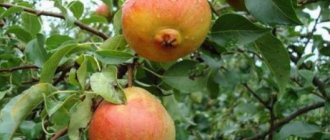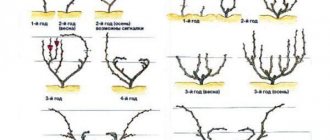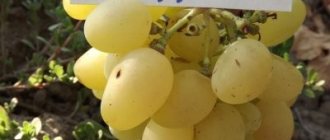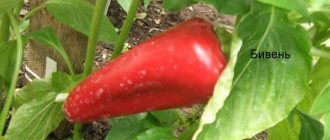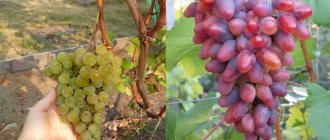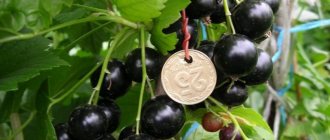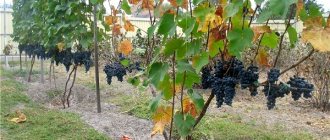Advantages and disadvantages
Advantages:
- Presentable appearance: large clusters and large berries.
- Excellent harmonious taste.
- Abundant harvest.
- Bisexual flowers.
- Possibility of storage up to 3 months.
- Market demand.
- Relatively early ripening.
Flaws:
- Tendency to peas and cracking.
- Low frost resistance.
- High susceptibility to diseases and pests.
- The need for frequent treatments and covering for the winter.
Advantages of the variety
After such a description, many might think that it is better not to deal with him. That’s right, gardeners often do just that. But, if you don’t mind the time, and you like to put your soul into your plants, then you will notice that Rizamat also has its own advantages. They look like this:
- It makes excellent large raisins.
- Rizamat bunches are quickly sold out in the market due to their taste and attractiveness.
- Thanks to the bisexual inflorescence, you don’t have to worry about a decrease in yield or fruit peas.
- Thanks to the dense shell, the fruit is protected during transportation.
Origin
Reference! The grapes received this name in honor of the famous master of viticulture of Uzbekistan Rizamat Musamukhamedov, Hero of Socialist Labor, Stalin Prize Laureate, Honorary Academician of the Academy of Sciences of the UzSSR.
The “rizamat” grape was bred in the mid-twentieth century by Uzbek breeders G.V. Ogienko, K.V. Smirnov, A.F. Gerasimova in the Samarkand branch of NPOSViV named after R. Schrader. The mid-early variety was given life by the southern varieties “Katta-Kurgan” and “Parcent”, but the brainchild surpassed both its parents and all the expectations of the breeders in its organoleptic and external characteristics. There is also a variety “descendant of Rizamat”, which is very early and in many ways superior to its “parents”.
Parents of “rizamat” are “katta-kurgan” and “parkent”
Advantages of Rizamat
The Rizamat grape is a hybrid that is quite a popular variety among winegrowers for a reason, but because of its unique advantages:
- Grapes can be used for different purposes;
- yields are always stable and high;
- the berries are quite attractive and appetizing in appearance;
- flowers are bisexual;
- harmonious combination of acidity and sugar content;
- fully ripe berries can stay on the bushes for about two months without falling off;
- there is demand in the market;
- easy transportation.
Main characteristics
“Rizamat” is a real delicacy. It can be served fresh as a dessert and snack; it is also used to make tasty and large raisins, juice, and compote.
Ripening period
The variety is mid-early: this means that its growing season lasts 130 – 150 days. Typically, the harvest in the southern regions is ready for harvest in late August - early September.
Bush
The “rizamat” bush is large, and this must be taken into account when planting: the distance to the nearest “neighbor” should be at least 5–6 meters. An even better option: plant grapes alone, assuming that the plant will need 10 - 12 meters of free space. There will be no difficulties with pollination, since its flowers are bisexual. More details about the grape planting scheme can be found in a separate article.
You can choose any shape of the bush: five-meter shoots are difficult to organize in any way. Supports will definitely be needed: arches, trellises - those structures to which powerful vines can be securely attached.
Important! Free space for the “rizamat” bush is an important component of a bountiful harvest.
bunches
Bunches of “rizamat”
The variety's clusters are impressive with their significant size. The average weight ranges from 700 - 900 grams, but with properly organized care they can gain weight by 1.5 - 3 kg. The brush is conical in shape, loose, rather loose.
Berries
A real miracle is the grape berries: large, juicy, fleshy. Their weight ranges from 8 to 15 g, size – 30*20 mm. The shape of the berries is mainly cylindrical, but variations are possible, occurring even on one bush. For such large berries, the seeds are quite small, 3–4 per one, so you can hardly feel them when eating them.
The color of the fruit is pink, and the side that has been exposed to the sun longer has a deeper, rich burgundy-purple hue. The skin is thin, covered with a waxy coating of medium density. The pulp is juicy, dense, crispy.
Reference! “Rizamat” grapes, when fully ripe, have a sugar content of 18–25% with an acidity of 5–6 g/l. Tasters rate its organoleptic properties very highly: 9.1 points out of 10 possible.
Taste
High levels of sugar accumulation in the clusters determine the unusual sweetness of the variety, but without unpleasant cloying. The taste is harmonious, with light refreshing notes.
Planting grapes
It is advisable to propagate grapes by seedlings. To do this, parts of the trunk are selected and placed in water until the first roots appear. Another way: place the branches in moist soil. Some gardeners propagate Rizamat by layering. With this method, it is not recommended to quickly disconnect the branch from the mother trunk. Otherwise, the plant will be frail and require longer care.
Before planting seedlings, holes should be prepared. An important rule in this case is that the bottom lies two meters above groundwater. The holes are dug to a depth of about 80 cm. Crushed stone or broken brick is laid on the bottom. Approximately eight centimeters thick.
Next, you should fill the hole with soil 10 cm deep. Next, fertilizers are applied. Preferably organic (compost, manure). Some gardeners add phosphorus-potassium fertilizers. They are sprinkled with loose soil 10 cm thick on top. The pits are then left to settle for about 14 days.
Planting is recommended in the spring. In autumn, there is a danger that frost-resistant plants will die at the first frost. Or they will be frail and easily susceptible to disease.
When planting seedlings, some nuances should be taken into account. It is not recommended to plant them mixed with other grape varieties. Rizamat loves space and does not get along well with his neighbors. If the intention to form a common vineyard is still present, the distance between plants should not be less than 3 meters.
The distance from the fence and from the walls of the house should be at least one meter. When planting, the distance between the seedlings themselves is kept from one meter to one and a half meters. The Rizamat variety is light-loving and heat-loving. Therefore, it must be planted on the south side of the site.
Prepared seedlings are placed in pits, taking into account all the nuances. Two buckets of water are poured into it, and then covered with loose soil. It is advisable to mulch the soil on top. The shoots are tied to an upright support to give them direction of growth.
Important!
Many winegrowers believe that the soil under the bushes should always be moist. To do this, install a drip irrigation system.
Features of cultivation
“Rizamat” is a capricious variety that requires regular watering and fertilizing, systematic removal of weeds around, fertile soil, and constant treatments with fungicides.
Trimming
One of the main measures for caring for a plant is pruning the bush. The maximum recommended load on grapes is 40–50 buds, pruning size is 12–15 buds. If these recommendations are not followed, the berries will become smaller and the harvest volume will decrease.
Like any other “rizamat” variety, proper pruning is necessary.
It is also important to monitor the stepchildren; their growth may increase in the case of “excessive” circumcision. All shoots must be pinched during the entire growing season.
Attention ! Experienced winegrowers recommend pruning the variety only in the fall; removing excess shoots in the warm season will lead to low yields. In spring, only sanitary pruning of the bush is allowed: remove broken, frozen, damaged branches and shoots.
Diseases and pests
“Rizamat” grapes are not resistant to diseases and require, on average, at least 3 (maximum 7) treatments per season: when the sprouts reach 20 cm in length, before flowering and after it, when the berries become like peas. The weakest point of “rizamat” is oidium. It is very simple to protect the plant: it is enough to regularly ventilate the bushes, i.e. shoot them, tie up the shoots, remove the weeds around the bush in a timely manner.
Among the chemical preparations, we can recommend sulfur powder, which should be used to pollinate the plant, or fungicides, which are not difficult to purchase in specialized stores. Popular drugs are Horus, Strobi, Topaz, Tiovit Jet.
Another threat is wasps and birds. To protect against insects flying onto sweet, cracked berries, special baits with poison are usually placed. You can protect the plant from birds using nets that wrap the grape clusters.
Preparing for winter
A prerequisite for the growth of “rizamat” grapes is to ensure proper protection during the cold season, even in the southern regions of Russia, because the plant comes from Central Asia, where winter is a relative concept.
The algorithm of actions is as follows:
- Water the plant and prune it.
- At the base of the bush, the soil must be covered with a thick layer of humus and dry foliage (spruce branches).
- The vines must be removed from the supports and placed on the surface of the soil, having previously been wrapped in burlap or other insulation. On top is a layer of foliage and earth.
- After snowfall, high snowdrifts should be formed over the shoots.
Experienced winegrowers do not recommend wrapping vines in plastic alone. Winters are rarely constant, and at the first thaw inside such a “greenhouse” the vines and buds may damp out. Therefore, it is advisable to first wrap the lashes in burlap and only then in polyethylene with holes for ventilation.
Harvest storage
The variety is distinguished by its high yield: 30–80 kg can be harvested from one bush, and 200–250 centners from a hectare. After harvesting, the brushes must be placed in a special container. The variety is well transported and stored: in the refrigerator - up to 3 weeks, and in specialized chambers - up to 3 months.
Attention! It is important not to leave the bunches on the bushes too long after ripening: they will quickly lose their presentation, and wasps will significantly spoil the appearance of the berries.
Regions
It is recommended to grow this variety in the south of Russia, as well as in southern countries: Turkmenistan, Uzbekistan, Georgia, Moldova, Ukraine. The grapes will ripen in them by the end of August. But cultivating “rizamat” in a temperate climate (Central Russia) is problematic and requires a lot of effort. The berries will ripen in a cool climate compared to the south only by the end of September.
Care
As many winegrowers note, Rizamat is a rather capricious variety in terms of care. But if you approach its cultivation with responsibility, then it will please the owner with a high-quality harvest.
Watering
Rizamat needs to be watered constantly. The amount of water depends on the type of soil and climatic conditions. We water the crop well, but without waterlogging. When watering, it is also important to create ideal conditions when there is no waterlogging or drying out of the soil. Any changes in humidity cause cracking of the berries.
You can water under the bush, but this is the wrong watering scheme. Experienced gardeners install a pipe at the stage of creating a planting hole, into which water is subsequently poured. This allows you to use the water's potential to the maximum. It immediately gets under the root, does not dry out and does not spread.
We recommend reading: “Seedless grapes Kishmish 342”
But usually only specialists do this. If you are engaged in amateur cultivation, then you can simply dig a hole (near the trunk of the bush) and pour water into it. After this, the pit is covered with mulch.
Fertilizers
Rizamat is also demanding of fertilizers. The first fertilizers are applied to the hole during planting of the seedling. Typically, compost or humus reserves last for 1 year. In the second year of the crop’s life, it begins to be systematically fertilized. In the spring - nitrogen-containing fertilizers (chicken manure, etc.), in the fall - potassium-phosphorus fertilizers.
Rationing
An equally important procedure is rationing. Stepchildren must be regularly removed from the bush. This will not only reduce the load, but also thin out the bush, providing good ventilation.
Rizamat is a vigorous variety. When rationing it, there is no need to show pity for it. The shoots are cut into 6 eyes.
Protection against diseases
To protect the crop from fungal diseases such as mildew and oidium, grapes are treated with fungicides three times. The first two treatments are carried out before flowering begins, the last one, during the formation of berries (when they have acquired the size of peas).
Comparisons with analogues
In appearance, “rizamat” is similar to the “original”, “radiant raisins”: the same pink color and elongated shape of the berries, sweet, pleasant taste. All these varieties have in common a weak resistance to diseases.
Mid-season varieties “Amursky”, “Podarok Zaporozhye”, “Levokumsky”, “Talisman” win in terms of winter hardiness, but in terms of taste characteristics “Rizamat” is ahead of them, although, as they say, this is a matter of taste.
“Rizamat’s” productivity indicators are off the charts (250 kg per hundred square meters), as close as possible to it, but still significantly inferior to “Nadezhda AZOS” (160 kg), “Levokumsky” (138 kg).
Comparison of “rizamat” with several more varieties:
| Sign | Variety | |||
| Rizamat | Lowland | Chocolate | Ataman | |
| Ripening period | 130–150 days | 125 – 135 days | 135 – 150 days | 130 – 145 days |
| Frost resistance | -23C | -23C | -24С | -24С |
| Productivity | 30 – 80 kg | 30 – 60 kg | Up to 20 kg | Up to 20 kg |
| Bunches | 700 g – 3 kg | 1.5 – 3 kg | 800 g – 3 kg | 900 g – 2 kg |
| Taste | Harmonious with notes of freshness | Cherry notes | Harmonious taste with chocolate notes | Harmonious and refreshing |
| Color | Pink | Pink - purple | Red-brown | Dark purple |
| Disease resistance | Low | Above average | Above average | Above average |
| Shelf life | 3 months | Up to 2 months | Up to 3 months | Up to 4 months |
| Sugar accumulation | 18 – 25% | 18% | 18 – 20% | 16 – 20 % |
| Acidity | 5 – 6 g/l | 9 g/l | 5 – 6g/l | 6 – 8 g/l |
Disease Prevention
Since the Rizamat grape variety is not resistant to diseases, the plant should be regularly sprayed against diseases.
Treating the bush with copper sulfate or Bordeaux mixture 4–6 times during the growing season, depending on the weather, can prevent the appearance of fungal diseases. Comprehensive disease prevention also involves measures for tying up shoots, pinching and weed control (for better ventilation of the bush).
However, preventive measures do not always prevent infection. With timely detection of the disease and immediate application of modern fungicides, the crop can be saved with little loss.
The main symptoms of mildew infestation of grapes are damage to all green parts of the vine: leaves, shoots, inflorescences, berries and tendrils.
In particular:
- on young grape leaves the disease causes characteristic pale green or yellow slightly transparent oily spots of various shapes and sizes;
- longitudinal depressed brown spots appear on green shoots, tendrils and ridges;
- green inflorescences and berries turn brown and die.
The first signs of mildew are found on the leaves. The spread of the fungus is indicated by oily traces on their upper surface and an inconspicuous whitish coating on the back side of the leaf plate.
You can save the plant and the crop from mildew by treating the bush (especially the lower part of the leaves carefully) with systemic copper-containing preparations (Ordan, Ridomil, Polychom, Oxychom, Silk, etc.)
If you notice that the leaves have begun to curl, grayish spots have appeared on them, there is mold on the shoots, and brown spots are spreading on the vine - these are signs of oidium. The plant can be cured with colloidal sulfur or with the drugs Bayleton, Topaz, Skor, etc.
nadache.guru
Photo
Below, check out the photo of the variety and leave feedback about it.
Reviews
“My Rizamat is already 20 years old. Although it is capricious, the beauty of the clusters and the unsurpassed taste of the berries more than compensate for all the shortcomings of the variety. The bush of impressive size grows separately from other grapes; I let its vines hang on the arch for good ventilation. I definitely do autumn pruning.” Vladislav, Rostov-on-Don
“I heard a lot of complaints about Rizamat about his instability to diseases. I got used to working it three times a season. And for the winter, having removed the lashes from the support, I cover them with polyethylene, folded in several layers, which I press down to the ground with bricks. Rizhamat never froze!” Olga, Volgograd
“Although the climate is not entirely favorable for the variety - harsh winters and summer heat with little precipitation - it has been growing on my site for 6 years. From year to year, I treat the plant only once per season in order to prevent fungal diseases, and this turns out to be enough.” Vladimir, Krasnodar Territory
“From the very first try, I fell in love with the taste of grapes, and now I’ve been growing them for 8 years. Yes, they require a lot of trouble: pruning, processing, shelter for the winter. But sweet and crispy berries will be a worthy decoration even for a holiday table. In addition, the variety sells well, which is also important.” Dmitry, Saratov region.
Rizamat is a real diamond of the grape collection, which real professionals can appreciate. Although its cultivation will require responsibility and time from the winegrower, all inconveniences and difficulties are immediately forgotten when the first bunch begins to appear on the vine.
